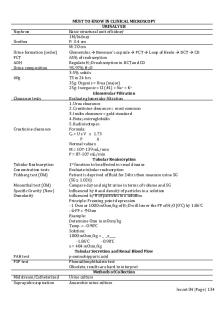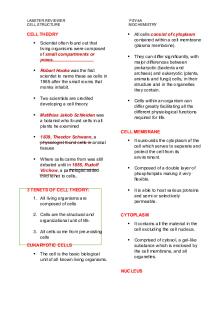Microbiology labster microscopy PDF

| Title | Microbiology labster microscopy |
|---|---|
| Author | Rebecca Simmons |
| Course | Introduction To Microbiology |
| Institution | Gonzaga University |
| Pages | 4 |
| File Size | 128.9 KB |
| File Type | |
| Total Downloads | 89 |
| Total Views | 130 |
Summary
Download Microbiology labster microscopy PDF
Description
Lab Summary Form -Fall 2020 ●
●
●
Use this form to write notes in as you do the Labster Simulations or read scientific articles. Make a print copy before beginning a Labster Simulation because they only work in Full Screen mode. Once the simulation/reading is completed, and your notes have been cleaned up to be concise and clearly written, then submit your Lab Summary using this same form to your Blackboard section Assignment Box by 5PM the Sunday following lab. A .pdf of a scanned hand-written Lab Summary Form is acceptable if neatly written, or revised and edited notes typed in this same Lab Summary Form can be submitted.
Lab/Research Article Title:____Microscopy__________________ Source & Date published (or Labster Lab):__________ Labster _____________________
Question (Grey fill =topics to keep notes WHILE doing simulation)
Lab Summary Notes
Points earned
Q1: Overall simulation/Exp eriment described in 4 sentences or less
Q2: Primary Question asked ?
Q3: Primary Question written as a hypothesis and tested in the experiment
Use different microscopy techniques to investigate the cause of a mysterious viral disease. We are finding the tiny virus that wreaks havoc on the gut.
/2 pt If we figure out how the virus managed to stop the inflammatory reaction in the small intestine we might be able to replicate this mechanism to produce a drug for celiac patients. /2 pt If we observe the intestinal tract of a infected chicken, then we could be able to develop a medicine for coeliac disease, because we will see how it works and what it does at the microscopic level.
/1 pt 1- Use the microscope to observe the sample of intestine.
Q4: List MAIN methods in order performed (Or describe if name unknown)
2- Observe the sample with TEM. 3- Use the florescent microscope. 4/1 pt 51- Observe the chicken intestinal slides. They are stained with anilin, orange G and fuchsin. Observe the various cells and tissue and nuclei.
Q5: State purpose of each Method above OR what was measured/acc omplished by test
2- TEM helps us see very small things. Observe microvilli, mitochondria and junctions and other cell structures of the chicken intestine slide. 3- It enables us to visualize microscopic structures at such a high contrast. (get an image of the epithelium). Observe the chicken intestine sample that’s infected with the virus. We saw how it inhibits inflammation and how it infects the lymphocytes. 45-
/4 pt
Q6: Statement as to whether data supported hypothesis or not, and reasoning for statement is clear
Q7: Final conclusion is stated clearly and concisely
Q8: Interesting research as follow-up, or new questions to ask? Reason why given?
We were able to see and identify what happened to the infected chicken. We saw that the virus infect lymphocytes and delays the immune response and the onset of inflammation.
/2 pt The retrovirus can now be further developed as a medicine for coeliac disease. We found out how it infects lymphocytes, delays immune response, and what it looks like at the microscopic level. /1 pt
I know of a few people that have coeliac disease. I was wondering if this is the information they have already found in the past to help provide medicine for people with this disease. I really enjoyed learning about the microscopes, how they work, what they do, etc.
1/pt
Other notes, questions, observations: DAPI The virus seems to infect lymphocytes specifically. They might bind to a membrane protein that is only expressed in lymphocytes. By infecting the lymphocytes it somehow manages to delay the immune response and the onset of inflammation. Therefor, we cant see any inflammatory symptoms a few days after infecting the chickens with al three viruses. The viruses are obviously still there and the delay in the immune response leads to a very strong infection.
Total points: /15 pt...
Similar Free PDFs

Microbiology labster microscopy
- 4 Pages

different microscopy
- 4 Pages

Week2 labster
- 4 Pages

CM-handouts - Clinical Microscopy
- 32 Pages

Microscopy - Lecture notes 2
- 3 Pages

Microbiology
- 7 Pages

Protein Denaturation in Labster
- 7 Pages

Week 4 Labster Activity
- 4 Pages

Crispr - Paper( Labster)
- 3 Pages

Labster Report Organic Chemistry
- 23 Pages

MUST-KNOW Clinical Microscopy
- 43 Pages

Bio week 1 labster
- 4 Pages

Labster 1 cell structure
- 10 Pages

Summary for Labster
- 5 Pages
Popular Institutions
- Tinajero National High School - Annex
- Politeknik Caltex Riau
- Yokohama City University
- SGT University
- University of Al-Qadisiyah
- Divine Word College of Vigan
- Techniek College Rotterdam
- Universidade de Santiago
- Universiti Teknologi MARA Cawangan Johor Kampus Pasir Gudang
- Poltekkes Kemenkes Yogyakarta
- Baguio City National High School
- Colegio san marcos
- preparatoria uno
- Centro de Bachillerato Tecnológico Industrial y de Servicios No. 107
- Dalian Maritime University
- Quang Trung Secondary School
- Colegio Tecnológico en Informática
- Corporación Regional de Educación Superior
- Grupo CEDVA
- Dar Al Uloom University
- Centro de Estudios Preuniversitarios de la Universidad Nacional de Ingeniería
- 上智大学
- Aakash International School, Nuna Majara
- San Felipe Neri Catholic School
- Kang Chiao International School - New Taipei City
- Misamis Occidental National High School
- Institución Educativa Escuela Normal Juan Ladrilleros
- Kolehiyo ng Pantukan
- Batanes State College
- Instituto Continental
- Sekolah Menengah Kejuruan Kesehatan Kaltara (Tarakan)
- Colegio de La Inmaculada Concepcion - Cebu

